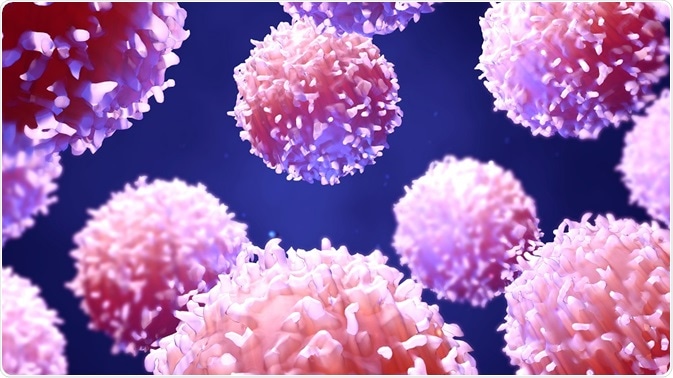By Megan Knight, BSc
A controlled supply of nutrients is extremely important in the immune system, which is tightly regulated by many pathways, including metabolic processes. Uncontrolled immune activation can have severe long term complications, including autoimmune and allergic syndromes, cancer and transplantation rejections. One immunoregulatory pathway is the IDO pathway.
 Image Credit: Design_Cells / Shutterstock
Image Credit: Design_Cells / Shutterstock
What is IDO?
The enzyme Indoleamine 2,3 dioxygenase (IDO) is part of a metabolic pathway which is responsive to signalling molecules which either induce or are associated with inflammation. IDO has a diverse range of functions within innate and adaptive immune responses.
IDO expression is limited to a specific range of cell types called antigen presenting cells (APCs), giving IDO a crucial role in a host immune response to infection. However, the immunological effects of IDO are not confined to cells which express it.
The secretion of downstream metabolites from APCs expressing IDO triggers responses in the neighbouring T cells. Normally, IDO expression is tightly regulated; it is rapidly targeted for degradation in cells in the absence of inflammation.
Activation of IDO
IDO is activated by a group of immune signalling proteins called interferons. Type I and II Interferons are released by the host cells following bacterial and viral infections.
Other stimuli which result in IDO activation include the release of pro-inflammatory cytokines, such as TGF-β and IL-1, as well as the detection of T-cell costimulatory receptors by dendritic cells (DCs). These signals induce rapid upregulation of IDO within cells in the presence of sustained inflammation.
Functions of the IDO Pathway
The IDO pathway modifies immune system and immune regulation. Depleting sources of tryptophan via the IDO pathway results in the inhibition of T cell responses in both the innate and adaptive immune responses, promoting immune tolerance.
Immune tolerance is the state of immunological unresponsiveness to an antigenic challenge. It prevents excessive immune response and tissue damage, and encompasses both central and peripheral tolerance. IDO also plays a role in establishing peripheral tolerance mechanisms.
IDO enforces peripheral tolerance via tryptophan depletion in T cells by its effects on cell cycle arrest, apoptosis, and anergy, which is the inactivation of T cells in response to a particular stimulus.
Pathogen regulation
Nutrient starvation is an ancient, evolutionary strategy of the innate immune response to a pathogen. IDOs role in tryptophan depletion allows control of pathogen proliferation, which includes parasites, viruses and bacterial species.
Several tissue culture experiments have shown that activation of IDO limits the ability of several pathogenic species to reproduce, and that tryptophan administration reverses the regulatory effects of IDO. It is also an advantage that IDO limits mammalian cell growth during an infection, as viral replication is dependent on host cell metabolic machinery.
Immune regulation
IDO also mediates T cell tolerance along with directly controlling pathogen multiplication during host cell defence response. This level of metabolic regulation controls inflammation to prevent an aberrant immune response. However, the effects of IDO could also contribute to persistent infections, leading to long term complications.
Several intermediates of the kynurenine pathway downstream of IDO can inhibit T cell proliferation by inducing cell cycle arrest. They also induce apoptosis at higher concentrations and anergy of activated T cells. Activation of IDO can alter the balance of T cell subsets within the immune system.
The IDO Pathway and Disease
The role of IDO in dampening the immune response means it also has a crucial role in the pathogenesis of persistent infections and cancer. However, the effects of IDO are beneficial in inducing tolerance to transplanted organs, and the suppression of local tissue inflammation and autoimmunity.
IDO is overexpressed in many types of cancer where high IDO expression correlates to a poor patient prognosis. IDO overexpression suppresses local immune responses within the tumour microenvironment.
This could also induce systemic immune tolerance towards the tumour cells, preventing their elimination by effector immune cells. Therefore, IDO is an attractive target in immunotherapy.
During chronic inflammation, IDO activity becomes elevated in the CNS. This correlates with heightened pain and neurological depression experienced in the presence of chronic inflammatory syndromes. This suggests that suppression of IDO in chronic inflammatory syndromes could rescue neurological complications.
Sources:
- Munn, D. H., Mellor, A. L. Indoleamine 2,3 dioxygenase and metabolic control of immune responses. Trends in Immunology. 2013: 34(3); 137-143
- Barth, H., Raghuraman, S. Persistent infectious diseases say – IDO. Role of indoleamine-2,3-dioxygenase in disease pathogenesis and implications for therapy. Critical Reviews in Microbiology. 2014: 40(4); 360-368
- Fallarino, F., Grohmann, U., Puccetti, P. Indoleamine 2,3-dioxygenase: from catalyst to signalling function. European Journal of Immunology. 2012: 42; 1932-1937
Further Reading